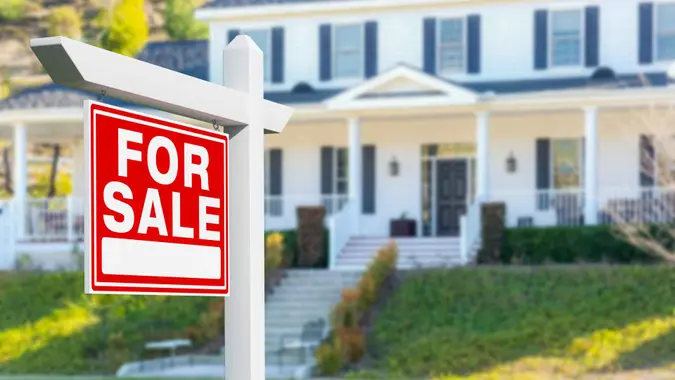I Bought a House for $1 and Renovated It — Here’s How Much It Cost

Commitment to Our Readers
GOBankingRates' editorial team is committed to bringing you unbiased reviews and information. We use data-driven methodologies to evaluate financial products and services - our reviews and ratings are not influenced by advertisers. You can read more about our editorial guidelines and our products and services review methodology.

20 Years
Helping You Live Richer

Reviewed
by Experts

Trusted by
Millions of Readers
Buying a home is an enormous decision, especially given the current housing market — one boasting high mortgage rates, soaring prices and low inventory. Yet, some people, such as Maxine Sharples, were able to buy one for 1 pound ($1.27), as part of the “homes for a pound” program created to revive the Webster Triangle — a small run-down area in Liverpool — as she detailed in a CNBC article.
“But there was a catch: the home was in complete disrepair. To qualify, I had to be a first-time homeowner and be able to fix it up within a 12-month period. The council estimated that the renovations would cost $61,400,” she wrote.
Is Buying an Extreme Fixer-Upper Worth It?
While this situation might sound appealing, whether it is really financially wise to buy a home in disarray and pour money into it depends on several factors.
“The answer to whether buying cheap and renovating is worthwhile is, of course — it depends on your appetite for risk, the unexpected — and dust,” said Zach Robbins, founder at Loanfolk. “A major renovation is not for the faint of heart: It is nothing like the HGTV home reno or flipping shows and is likely to be much more expensive and disruptive than you originally anticipated.”
Robbins added, however, that it is also an incredibly rewarding journey — one which can be quite profitable if you set reasonable expectations and plan accordingly.
For instance, Yancy Forsythe, owner and founder of Missouri Valley Homes, said he once purchased a property in Kansas City, “not for $1, but the purchase price was a steal at $50,000.”
Forsythe explained that after buying the property, he started on renovations, focusing solely on what he deemed “essential” ones.
Here is what he spent: $10,000 on modernizing the kitchen, $7,500 to refurbish two bathrooms, and another $5,000 on fresh paint and landscaping to enhance curb appeal. Additional minor updates and repairs cost about $3,000.
“In total, our investment was $75,500. We ended up selling this property for around $120,000 — for a profit of $44,500 in just under four months,” said Forsythe.
“This was absolutely a wise financial decision because we made a profit of $44,500 in a short period of time.”
Factors To Consider Before Buying a Serious Fixer-Upper
As Mark Poole, real estate investing expert and founder of Smarter Property Investment, noted, there are similar “house for $1” initiatives in Europe, particularly in Italy. And in Croatia, you can buy a house for 13 cents in the town of Legrad, largely thanks to a 2018 initiative aimed at attracting more people to the area, per CNBC.
While this might be tempting, there are factors to consider. First, Poole said, the houses are completely derelict and you will need considerable funds and / or expertise to bring them up to standard.
In addition, inflation and supply chain issues have caused the cost of building materials to rise.
“You could expect to spend a six-figure sum to completely renovate a house to the required standard, especially if you need to employ builders and tradesmen to complete all of the work,” he added, noting that part of the condition of the scheme is that the renovation works have to be completed within a year. Otherwise, the council could take away your keys.
“So you are exposed to the risk of what you have already financially committed to the project if you don’t complete it on time,” he said.
Perhaps most importantly, given the location, house values are relatively low. Therefore, it would be entirely possible to spend more on the property than it’d be worth on the resale market — meaning you lose money.
“Capital growth in such locations is either very low or non-existent. So your invested money is unlikely to see much of a return over the years of ownership,” he added.
According to Poole, given the need for “considerable funds” to complete the renovations, it makes much more financial sense to use those funds as a deposit to purchase a property in a more desirable location, using a mortgage to do so.
More From GOBankingRates
 Written by
Written by  Edited by
Edited by 

























